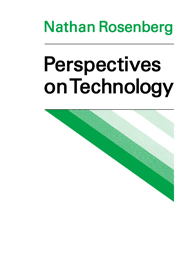Book contents
- Frontmatter
- Contents
- Acknowledgments
- Introduction
- Part 1 Some origins of American technology
- Part 2 The generation of new technologies
- Part 3 Diffusion and adaptation of technology
- Part 4 Natural resources, environment and the growth of knowledge
- 12 Technology and the environment: an economic exploration
- 13 Technological innovation and natural resources: the niggardliness of nature reconsidered
- 14 Innovative responses to materials shortages
- 15 Science, invention, and economic growth
- Epilogue
- Notes
- Index
14 - Innovative responses to materials shortages
Published online by Cambridge University Press: 09 January 2010
- Frontmatter
- Contents
- Acknowledgments
- Introduction
- Part 1 Some origins of American technology
- Part 2 The generation of new technologies
- Part 3 Diffusion and adaptation of technology
- Part 4 Natural resources, environment and the growth of knowledge
- 12 Technology and the environment: an economic exploration
- 13 Technological innovation and natural resources: the niggardliness of nature reconsidered
- 14 Innovative responses to materials shortages
- 15 Science, invention, and economic growth
- Epilogue
- Notes
- Index
Summary
The central concern of this paper is with the adequacy of natural resource supplies to support an indefinite continuation of high rates of economic growth in advanced industrial economies. It is inspired – if that is the right word – by a recent spate of apocalyptic literature purporting to show that natural resource constraints impose an insuperable obstacle to such growth. I will suggest that this extreme pessimism is unwarranted because it attaches insufficient weight to an impressive array of adaptive mechanisms through which a market economy responds to shifting patterns of resource scarcity. Most important, I will argue that technological change is, in the long run, the most powerful mechanism of response.
Some disclaimers are in order. It should be obvious that no amount of historical analysis can provide an adequate basis for optimism concerning our future prospects. Evidence of past successes in dealing with natural resource constraints cannot, by itself, disprove the possibility that we may now have arrived at some crucial turning point or reached the end of an historical epoch. Equally obviously, arguments drawn from the past history of countries which have demonstrated a high degree of technological innovativeness are not likely to be directly applicable to countries where such skills and talents have been notably lacking. The purpose of my recourse to history is, therefore, relatively modest. It is simply to provide some insight into the manner in which economies possessed of a high degree of technological versatility have adapted to changing patterns of resource scarcities. History can, I believe, enlarge our awareness of the nature and possible range of these mechanisms.
- Type
- Chapter
- Information
- Perspectives on Technology , pp. 249 - 259Publisher: Cambridge University PressPrint publication year: 1976
- 3
- Cited by



